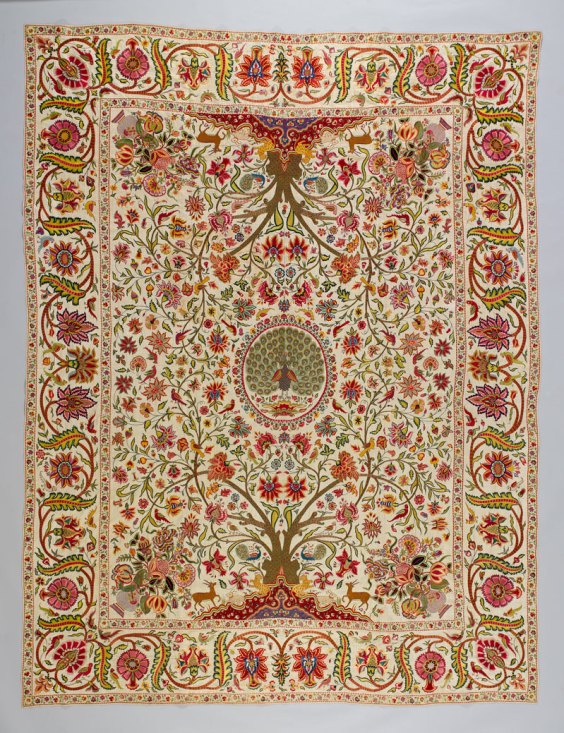In 1614 the Dutch East India Company (VOC) ship De Gelderland was shipwrecked of the coast of the Banda Islands (Indonesia). On board were a staggering 69,057 pieces of porcelain, intended for the Dutch market. ‘Asia in Amsterdam’ at the Rijksmuseum explores the impact of the trade with Asia on Dutch art and culture in the 17th century. The show brings together a variety of objects, from Chinese porcelain and Japanese lacquerware, to Dutch delftware and still life paintings. Curators Jan van Campen and Femke Diercks picked out some of their favourite objects.

The Return to Amsterdam of the Second Expedition to the East Indies (1599), Hendrik Cornelisz Vroom. Oil on canvas. Rijksmuseum, Amsterdam
The Return to Amsterdam of the Second Expedition to the East Indies (1599) Hendrik Cornelisz Vroom
This painting by Vroom perfectly illustrates the excitement that the trade with Asia caused in the Dutch Republic on the threshold of the 17th century. After an earlier failed attempt the Second Expedition to ‘the East’ successfully returned to Amsterdam in 1599 laden with precious spices. Three years later the Dutch East India Company (VOC) was founded. The Asian trade prompted with a period of unprecedented economic growth and a taste for luxury goods among the Dutch burghers.

Sweetmeat set with the coat of arms of Johannes Camphuys (1671–1690), Jingdezhen, China. Peabody Essex Museum Salem, museum purchase with funds donated by the Asian Export Art Visiting Committee
Sweetmeat set with the coat of arms of Johannes Camphuys, (1671–1690), Jingdezhen, China
Chinese porcelain has become almost synonymous with the trade in Asian luxury goods. The VOC imported porcelain in very large quantities. This lowered prices, making it available for a relatively wide section of the population. The most affluent buyers distinguished themselves by the quality of the porcelain they acquired or by ordering pieces with personalised decorations, such as this famille verte sweetmeat set with the coat of arms of governor-general Johannes Camphuys.

Chest (1635–45), Japan. Lacquer wood. Rijksmuseum, Amsterdam, Purchase with support from JT International Company Netherlands BV, the BankGiro Loterij, the Vereniging Rembrandt, and the Jaffé-Pierson Foundation
Chest, (1635–45), Japan
The Dutch had a unique relationship with Japan. From 1639 onwards they were the only western country allowed to trade directly with the Japanese. For only a brief period of time, between 1635 and 1645 a few Dutch merchants were able to order lacquerware of the highest quality ever produced for the export market. Five objects belonging to this so-called Fine Group will be brought together for the first time at the exhibition.

Casket (1618), attributed to Willem Kick. Casket, oak covered with imitation lacquer. Rijksmuseum Amsterdam
Casket (1618), attributed to Willem Kick
One way to consider the fascination with Asian luxury goods is to look at Dutch attempts to replicate Asian materials. Delftware – an imitation of Asian porcelain – is perhaps the best known example, but as early as 1609 the Amsterdam entrepreneur Willem Kick was given a patent for the production of an imitation of Japanese lacquer. His ‘lacquer’ became quite popular in a period when genuine lacquer was still hard to come by.

Still life with porcelain bowl, Nautulus Cup and Fruit (1662), Willem Kalf. Museo Thyssen-Bornemisza, Madrid.
Still life with porcelain bowl, Nautilus Cup and Fruit (1662), Willem Kalf
The enchantment with Asian luxury goods is also represented on Dutch still life paintings. Painters such as Willem Kalf excelled in the depiction these luxurious and exotic materials. The pearl-like shimmer of the turbo shell in the nautilus cup contrasts beautifully with the strong reflections on the gold mount. Kalf also included rare pieces, such as this covered bowls with the ‘Eight Immortals’, an example of which was present in the collection of Amalia of Solms, consort of prince Frederick Henry.

Palampore (bed cover) (1710–50), Deccan, India. Cotton embroidered with silk and metal-wrapped threads. Peabody Essex Museum, Salem, Veldman-Eecen Collection
Palampore (bed cover) (1710–50), Deccan India
Textiles formed an important component of the luxury goods imported by the VOC. This embroidered cotton bed cover was made in Deccan India. On first glance its decorations seem completely Asian, but when one looks closer it becomes apparent that the vases with flowers in the corners are actually based on a European print source. Objects in exotic materials and styles, that were none the less adjusted to Western taste had enormous commercial potential.

Bow Brooch (c. 1650–75), the Netherlands. Enamelled gold with pearls and rubies. Rijksmuseum, Amsterdam
Bow Brooch (c. 1650–75), the Netherlands
Today jewellery might not be your first association with Asia, but it was for the 17th-century Dutchman. In this era pearls were found mainly in the Gulf of Mannar and diamonds were only found in India and Borneo. They were among the best known and most precious Asian luxury goods. Amsterdam became the international center for the trade in pearls and diamonds. The Asian precious stones were used in jewellery with European designs – in this case wonderful brooch in the shape of a bow. Pearls of different sizes are accentuated by an array of small rubies.
‘Asia in Amsterdam: Luxury in the Golden Age’ is at the Rijksmuseum, Amsterdam, from 17 October–17 January 2016. The exhibition will travel to the Peabody Essex Museum in Salem, US from 27 February–4 June 2016.
The exhibition was made possible in part by the Mondriaan Fund and the Rijksclub and is co-organised by the Peabody Essex Museum, Salem, Massachusetts and the Rijksmuseum.
Unlimited access from just $16 every 3 months
Subscribe to get unlimited and exclusive access to the top art stories, interviews and exhibition reviews.














![Masterpiece [Re]discovery 2022. Photo: Ben Fisher Photography, courtesy of Masterpiece London](http://www.apollo-magazine.com/wp-content/uploads/2022/07/MPL2022_4263.jpg)
It’s time for the government of London to return to its rightful home